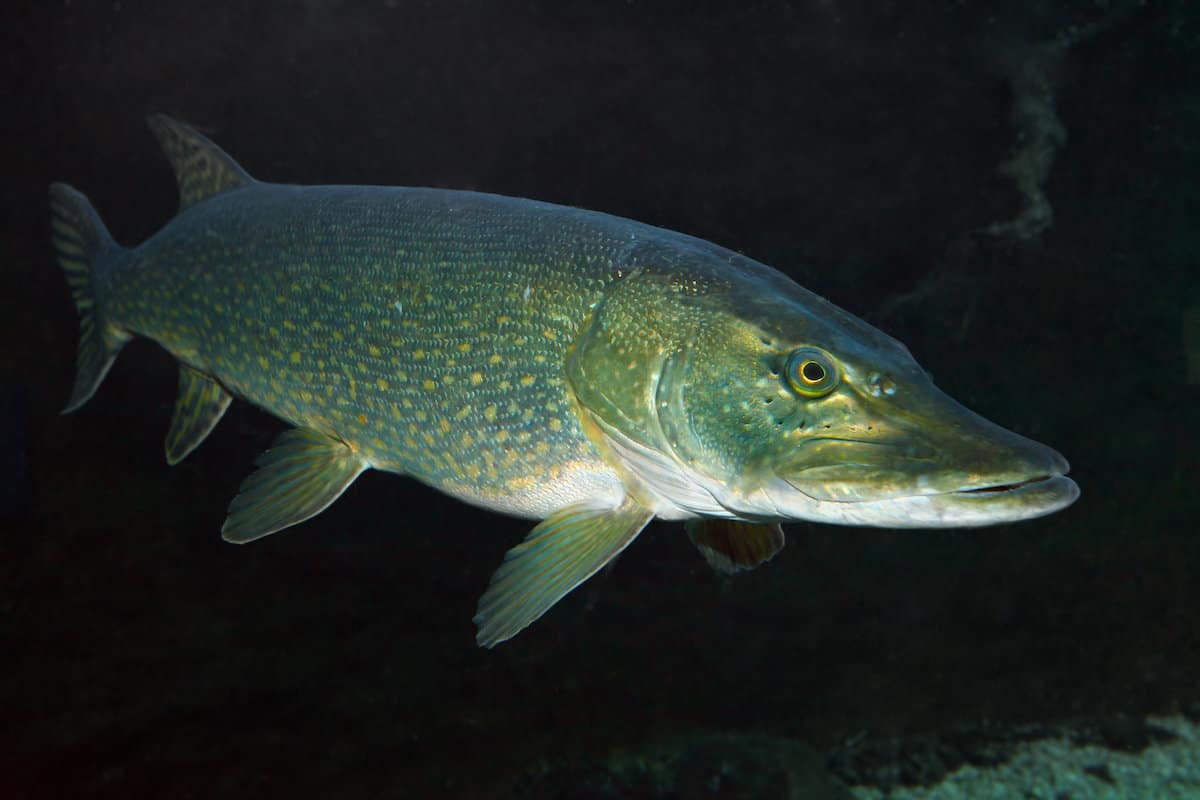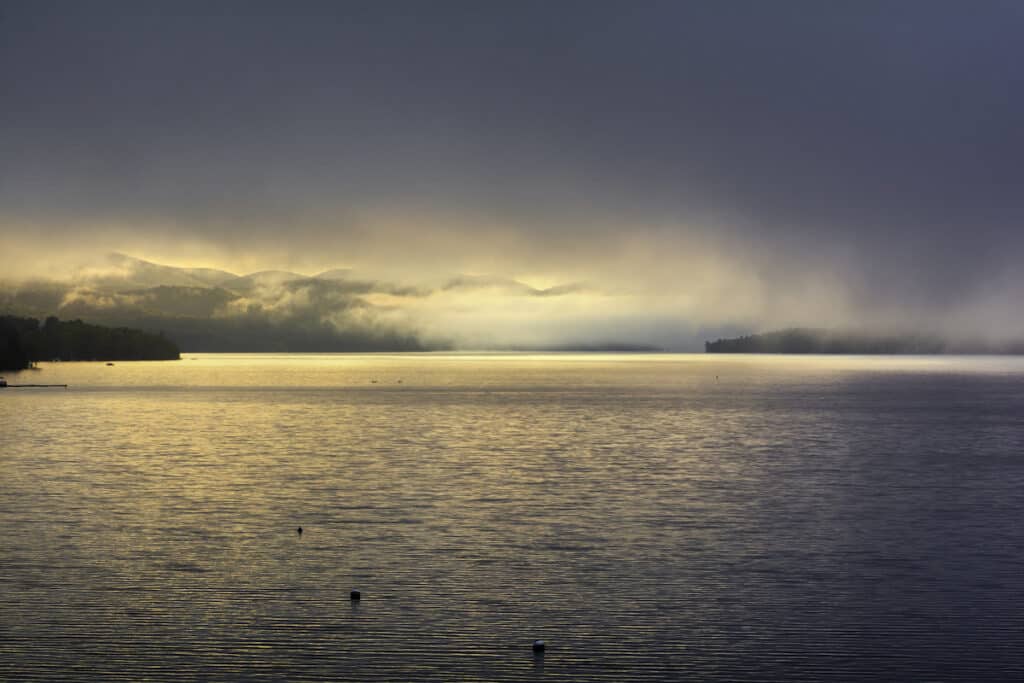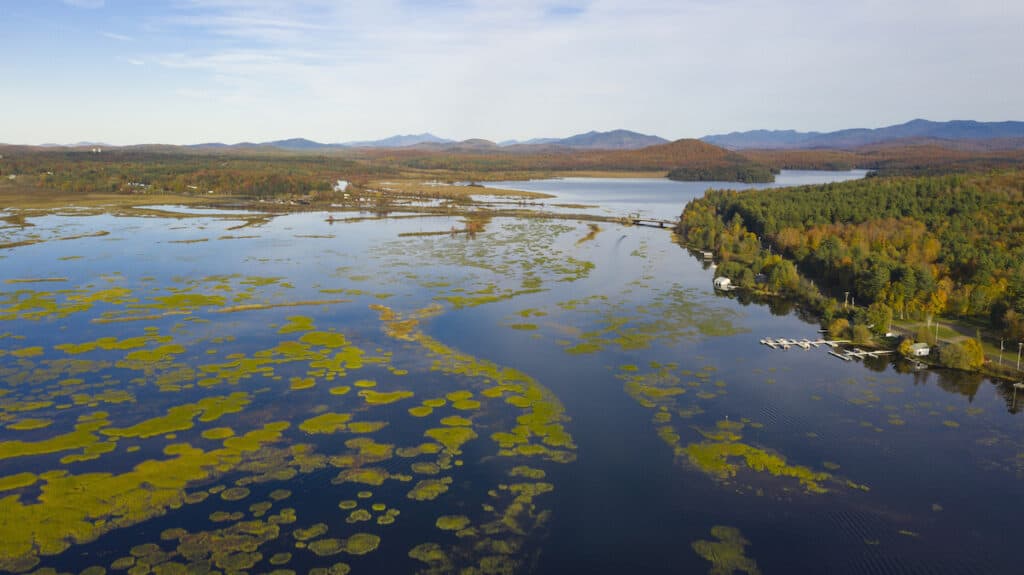When you look into the toothy maw of a northern pike, you know you’re looking at a fish that means business.
Pike are at the top of the food chain in most lakes they call home, and they’re voracious predators. It’s a rare bass fisherman in New York who doesn’t have a story about losing a favorite lure to a sudden, vicious swipe from a rogue northern.
Pike caught in New York commonly grow past the 3-foot mark and weigh 10 pounds or more. Occasionally they weigh much more; 20- or even 30-pound pike are an outside possibility in many of the lakes listed below.
Pike Fishing in NY
These fish thrive in shallow, weedy lakes, ponds and bays. It’s common to find pike in less than 10 feet of water in spring and fall. In summer, they often prowl the shallows around dawn and dusk, retreating to 10- to 20-foot depths during the day.
A wide range of lures and tactics can tempt them to bite.
Pike are fish-eaters, and any lure that looks like a bite-size baitfish can draw a strike. From classics like a red-and-white Daredevle spoon to more modern jerkbaits and spinnerbaits, anglers have a lot of options.
Live baitfish like shad, shiners, suckers and smelt are also tried and true options, especially for ice fishing. Pike will often grab a live minnow when all else fails.
Pike season in New York extends from the first Saturday in May until March 15 of the following year. Pike fishing is not allowed during the this time frame around April to allow the fish to spawn successfully.
Top 5 Pike Fisheries
The following are arguably the best handful of pike fishing spots in New York and also some of the better places to catch this thrilling game fish in the United States.
Great Sacandaga Lake
If you’re out for trophy pike—true giants pushing 40 inches and topping 20 pounds—then there’s no better place in New York than Great Sacandaga Lake.
Located at the southern edge of the Adirondack Mountains, Great Sacandaga Lake was created in 1930 with the completion of a dam on the Sacandaga River.
This reservoir spans 20,650 acres and has a well-defined river channel with 74-foot depths (though most of the lake is less than 30 feet).
Great Sacandaga Lake’s greatest claim to fame is New York’s state record pike, a 46-pound, 2-ounce behemoth that was caught on a Heddon Flaptail plug in 1940. That fish also reigned as the world record northern pike for around 40 years.
Weedy bays are some of the best spots. Try Woods Hollow Bay, Silver Bay, the North Broadalbin area, and around the mouth of Cranberry Creek. In summer, look for places where the river channel swings close to weedy shallows.
The area known as “stump alley” near Northampton is another great spot, especially in spring. A large area of flooded stumps was left behind when the reservoir was first built. Pike abound in this part of the lake until the water becomes too low to fish, as it usually does by the end of summer.
Pike in Great Sacandaga Lake enjoy a diverse diet that includes perch, alewives, white suckers and small carp, so a lot of different lures can be productive. Soft plastic jerkbaits, swimbaits and curly-tail grubs between 4 and 6 inches are all great choices.
Large spoons and stickbaits are favored by trollers while jigging spoons and live suckers are the preferred bait among ice fishermen. Some of the biggest pike of the year are pulled through the ice in January and February.
Several excellent public, state-operated boat ramps are available, as well as access through Northampton Beach Campground & Day Use Area.
Thousand Islands (St. Lawrence River)
There may be no place in New York where pike anglers have a higher catch rate than the Thousand Islands. Those who know the river well often enjoy 30-plus fish days in this vast island chain in the St. Lawrence River.
The Thousand Islands Region may not be quite the producer of big northerns that it used to be—old-timers will tell you the river has gone downhill since the early ‘90s—but there are loads of pike measuring 26 to 34 inches and tipping the scales between 4 and 8 pounds.
Monsters weighing 15 pounds or more are brought to the boat every year though. A lot of the perceived downturn in pike fishing over the past 30 years actually has more to do with fish behavior than the numbers of fish.
Since invasive zebra mussels were introduced in the 1990s, the water clarity in the St. Lawrence River has increased dramatically. Pike, as a result, usually roam deeper waters than they used to.
Of course, pike still spawn in shallow, weedy bays throughout the Thousand Islands. In springtime, Goose Bay, Chippewa Bay and Eel Bay all kick out a lot of good sized pike. Many are caught in less than 10 feet of water.
But in summer, you’ll seldom catch anything bigger than a 24-inch hammer-handle in shallow water. The big fish roam deep weed lines and ledges in 20 feet or more of water. Large pike will often suspend above 40-foot depths near steep drop-offs.
Good summer spots include the trench off Eel Bay (on the west side of Wellesley Island) and the drop-off just east of Chippewa Bay’s Cedar Island. Wellesley Island State Park, one of about a dozen state parks in the region, is a great place to launch.
A lot of tactics can be productive, so use lures you’re comfortable with. Spinnerbaits are excellent pike lures in the Thousand Islands, and they tend to work best if you add a chunky curlytail grub or other soft plastic to give it heft.
The Thousand Islands area also is among New York’s best spots for muskie fishing, so you may also hook into one of these toothy cousins while fishing for pike or the St. Lawrence River’s famous smallmouth bass.
More: Complete Guide to Fishing the St. Lawrence River and Thousand Islands
Seneca Lake
Several of the Finger Lakes—a chain of eleven long, narrow glacial lakes in Central New York—offer quality pike fishing. But none harbor more or larger pike than Seneca Lake.
Seneca Lake encompasses 43,343 acres, making it the largest of the Finger Lakes. With its 618-foot depths, it’s also the deepest lake entirely within the state of New York.
Cold and warm-water game fish thrive here equally, with northern pike being some of the most abundant of the latter.
Pike are always found in and around weed beds that dot the perimeter of Seneca Lake. A narrow band of shallow water encircles the entire shoreline, with silty flats and ample vegetation thriving right up until the first major drop-off to the lake’s yawning depths.
There are larger, more extensive shallows at the northern and southern ends of the lake, which are often the top places for pike fishing.
At the north end of the lake, around the city of Geneva, some of the best access is at Seneca Lake State Park. Boat launch facilities are available here, but some big pike are also caught right from shore, especially in spring.
At the south end of the lake, pike are often seen cruising in the crystal clear waters right alongside the public fishing pier in Watkins Glen. This is a great place to show up right at daybreak on summer mornings.
Alewives, known among local anglers as sawbellies, are a major forage species for pike in Seneca Lake. Using live alewives fished close to the bottom is common practice, both through the ice and in open water.
Large Rapala X-Raps and Husky Jerks are great alewife imitations that excel at tempting big pike in shallow water. Classic silver/black patterns are a safe bet, but pike in Seneca Lake are also known to dine on its abundant yellow perch, so have a perch-colored lure or two on deck.
Seneca Lake has an impressive collection of excellent fishing, including being among the best trout fishing lakes in New York.
More: Complete Guide to Seneca Lake Fishing
Saranac Chain of Lakes
The Saranac Chain of Lakes are among many, many great fishing lakes in the Adirondacks. Everything from pike and bass to rainbow and lake trout can be caught in these mountain gems, which total about 9,000 acres.
The chain comprises Upper, Middle and Lower Saranac Lake, along with Lake Colby, Lake Flower and Oseetah Lake. Ask local anglers which one has the best pike fishing, and you’ll get a lot of different answers.
Oseetah Lake might be the one that comes up most often. Shallow and weedy, Oseetah harbors an incredible abundance of northerns, but it is more of a numbers lake than a trophy fishery.
Pike average just a little over 24 inches in Oseetah Lake, and anything that hits the 36-inch mark is a notable catch. Even so, it’s easy to nab 20 or more in a day, which is a heck of a lot of fun even if they do run a little small.
Lower and Middle Saranac Lake offer some bigger fish, with lots of 5-pound pike and some weighing 10 pounds and up.
On Lower Saranac, focus on the weed beds toward the southwest end of the lake, as well as Pope Bay. On Middle Saranac, Hungry Bay is known as a hotbed of pike activity.
Several state boat launch sites are scattered throughout the chain. With the exception of Upper Saranac Lake, all the lakes are accessible to one another by boat, and canoes and kayaks are great for exploring the backwater areas.
Throughout the Saranac Chain, gold-colored spinners and spoons are favored by local anglers. They seem to look more natural than silver in the tannic, tea-colored Adirondack waters.
Sandy Pond (Lake Ontario)
Lake Ontario has a lot of amazingly productive bays and backwaters that provide tremendous pike fishing. A strong case could be made for Sandy Pond as the best of the best. Actually, there are two “Sandy Ponds.”
North Sandy Pond is a fertile embayment spanning 2,400 acres and separated from Lake Ontario by a narrow channel and a series of sandy barrier beaches. South Sandy Pond, much smaller at 295 acres, is connected to the main lake only through the northern pond.
When people talk about Sandy Pond fishing, they’re almost always talking about North Sandy Pond. With a maximum depth of 13 feet, it supports an abundance of healthy weed beds, and pike feel right at home here.
Anglers can effectively target pike in Sandy Pond throughout the legal season. Specimens topping 15 pounds are pulled through the ice every winter, and trolling along the edges of weed beds can be productive throughout the open water months.
Ice fishing aside, May and June are probably the best months for pike fishing in Sandy Pond. By mid-summer, pike will either be concentrated right around the deepest part of the pond, or hiding in the thickest weeds available.
Typical Sandy Pond pike run about 5 pounds. The pond is also known as great largemouth fishing water, and spinnerbaits often yield a mixed bag of bass and pike.
The best spinnerbaits for pike tend to be white, tandem willow leaf spinnerbaits with a bit of red. Try Strike King’s “Bleeding Shad” spinnerbait. In-line spinners like a size 5 Mepps Aglia (also in red and white) are killer pike lures too.
There are several public boat launch ramps around the perimeter of North Sandy Pond, in addition to the facilities in Sandy Island Beach State Park.
Honorable Mentions
Pike are everywhere in New York (including a few lakes where they are, technically, considered an invasive species).
Bottom line: anglers in search of pike have plenty of options. These other lakes, at times, might be just as good as the ones listed above.
Cranberry Lake
Pike aren’t supposed to be in Cranberry Lake, a 6,995-acre gem in the far North Country of St. Lawrence County.
These toothy predators were stocked illegally at some unknown point in time, and once pike find their way into a lake, they aren’t easily gotten rid of.
It would seem that invasive pike have fared exceptionally well in Cranberry lake. At least a couple of 45-inch northerns have been caught here, and there are solid numbers of 10- to 15-pounders.
If you catch a keeper pike in Cranberry Lake, the DEC encourages you to take it home with you. Some of the best pike action is in the weedy bay on the southwest arm of the lake near Wanakena, and in the northeast corner around Brandy Brook Flow.
Ice fishing can also be excellent. The state boat ramp just off Route 3, near the outlet dam in the Village of Cranberry Lake, is a great place to get on the water.
Cranberry Lake is managed as a brook trout fishery, and small brookies are certainly on the menu for the larger pike in the lake. Try a trout-patterned Rapala, or try a firetiger spoon, which has a lot of the same colors on it.
Silver Lake
At just 836 acres, Silver Lake is a small and often-overlooked dot of water in Western New York’s Wyoming County. It’s a well-balanced multi-species fishery that supports northern pike as well as walleye, largemouth and smallmouth bass.
Troll a stickbait along the edges of Silver Lake’s shallow weed beds in springtime, and you’re likely to catch any or all of the above species. That unpredictability makes Silver Lake an exciting place to fish.
Anglers who are out for pike specifically usually drift live shiners or cast/troll with F18-sized Rapalas. Larger Mepps spinners and classic red-and-white spoons are great too.
Silver Lake gives up more than its fair share of healthy pike measuring 36 inches and up, but most of the fish here run smaller. Expect most pike to be between 18 and 25 inches, with the occasional bruiser.
Bank and boat access is available at Silver Lake State Park. Late spring and early summer offer great pike action. Fishing pressure can be heavy from local anglers in summer, so try to visit on a weekday to beat the crowds.
Sodus Bay (Lake Ontario)
Less than an hour east of Rochester, Sodus Bay is one of many productive bays lined up along the shore of Lake Ontario. It’s perfect pike habitat, with 3,357 acres of mostly shallow, weedy water.
Pike in the 24- to 30-inch range abound in Sodus Bay along with the occasional much larger fish. A handful of 15-pounders are brought to the boat most years.
The majority of Sodus Bay’s pike are caught along weed lines in 8 to 15 feet of water. The most productive areas are places where drop-offs and weed beds intersect.
Waters off Grassy Point and around Eagle Island are some of the best, but there are countless excellent spots in the bay.
Spring and fall are the best times for pike fishing in Sodus Bay. Some solid pike are caught in summer too, but smaller fish are the norm this time of year.
Weed growth becomes excessive by mid-summer, and largemouth bass become the dominant game fish.
Bass tournaments are common this time of year, but bass anglers often hook into a toothy pike by mistake (and often lose a lure in the process).
Winter is many local ice anglers’ favorite time to catch pike in Sodus Bay, with live minnows on tip-ups being the preferred presentation. Pike can be anywhere from 6 to 20 feet of water during the colder months.
Conesus Lake
One of the smaller Finger Lakes, Conesus Lake is the westernmost in the chain. It’s a long, narrow lake of 3,420 acres that harbors some truly massive pike. DEC fish population surveys have netted individuals in excess of 30 pounds.
You’re more likely to tangle with 2-foot barely-a-keepers than 4-foot behemoths, but the fact remains that there’s a real shot at a trophy in Conesus Lake.
The problem is often getting them to bite. Pike in Conesus Lake are extremely well-fed by the lake’s abundant alewife population, so tempting a big one isn’t always easy.
Ice fishing in winter tends to be the best bet. Ice anglers at both ends of the lake and off the Long Point Park area often catch big pike on live minnows.
During the warmer months, the best way to find pike is trolling the deep edges of weed beds at about 15 feet.
Pike season is closed between March 15 and the first Saturday in May, but it’s worth visiting Conesus Inlet Wildlife Management Area at the south end of the lake in mid-April to watch the pike as they make their way up the inlet to spawn.
You’ll see some real giants in the crystal clear shallows. Some of the best pike fishing right after the season opener is on the shallow flats adjacent to the inlet at the south end of Conesus Lake.
The lake also hosts other popular game fish species, including at times some very good walleye fishing.
Tupper Lake
Surrounded by the densely wooded slopes of the Adirondack Mountains, Tupper Lake is one of New York’s most picturesque fishing lakes. It also has a well-established pike population that includes some true giants.
Tupper Lake spans 3,853 acres, and is part of a chain of interconnected waterways that also includes Raquette and Simon Pond. All three offer an abundance of shallow, weedy water in which pike thrive.
The DEC operates a boat launch site on Route 30 that overlooks the southern shore of Tupper Lake, which is a great place to start exploring. There’s some good shore access here, and Tupper Lake is also a perfect lake for canoes, kayaks and other small craft.
Smelt are pikes’ primary forage in Tupper Lake, and lures that mimic smelt are often met with vicious strikes. Silver floating Rapalas have a perfect smelt-like profile, but soft jerkbaits like Zoom Flukes are also highly effective.
The area where the Bog River enters Tupper Lakes is one of the best fishing spots on the lake. There’s a major smelt run in the river every spring which—if the weather cooperates—often aligns with the beginning of pike season.
Fair Haven (Lake Ontario)
Last but not least, Fair Haven Beach State Park is a great fishing location, nestled in a crucial spot on Lake Ontario. Pike are one of many species that anglers can target here throughout the year.
The state park surrounds Sterling Pond, a shallow, weedy embayment where Sterling Creek empties into the lake. It’s major spawning grounds for pike in springtime, and the weedy backwaters toward the rear of this 83-acre pond harbor pike all summer long.
Just a few hundred yards away is the mouth of Little Sodus Bay (not to be confused with the larger Sodus Bay, about 20 miles west) which spans 750 acres and is also a major pike stronghold in the Fair Haven area.
Aside from the spring spawning season, Sterling Pond mostly yields smaller pike in the 18- to 24-inch range. But Little Sodus Bay harbors bigger fish, with plenty of 3-footers that cross the 10-pound mark.
A long, L-shaped fishing pier separates Little Sodus Bay from Lake Ontario. Pike are often caught from both the lake and bay sides of the pier, along with largemouth and smallmouth bass.
Fair Haven Beach State Park includes a modern launch ramp on Little Sodus Bay, as well as a hand launch for cartop boats on Sterling Pond. The park also includes two campgrounds and one of Lake Ontario’s most beautiful swimming beaches.




